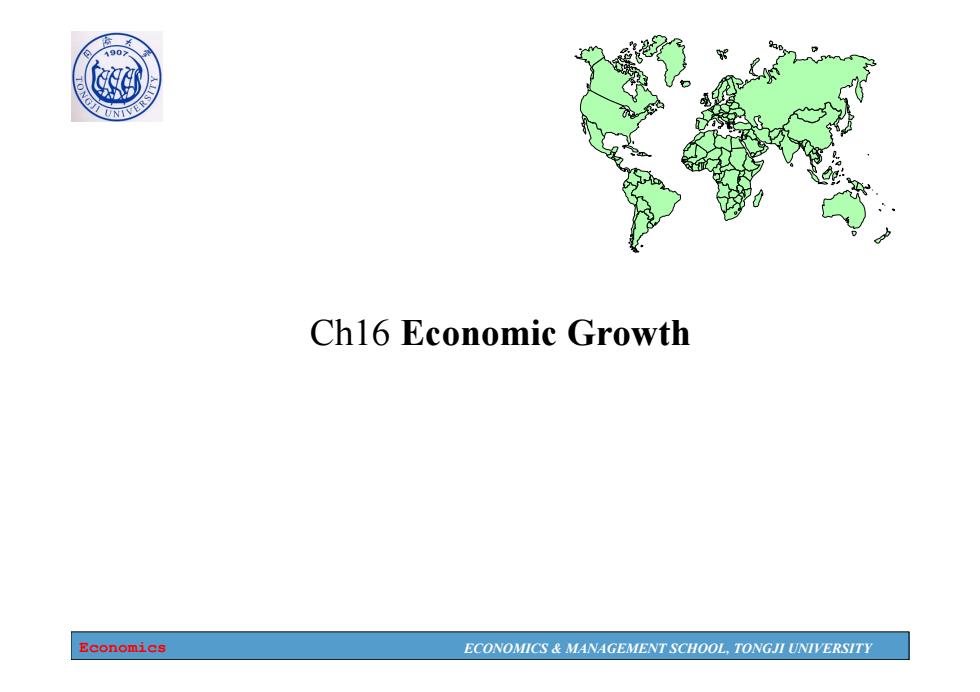
40 Ch16 Economic Growth Economics ECONOMICS MANAGEMENT SCHOOL,TONGJI UNIVERSITY
Economics ECONOMICS & MANAGEMENT SCHOOL, TONGJI UNIVERSITY Ch16 Economic Growth
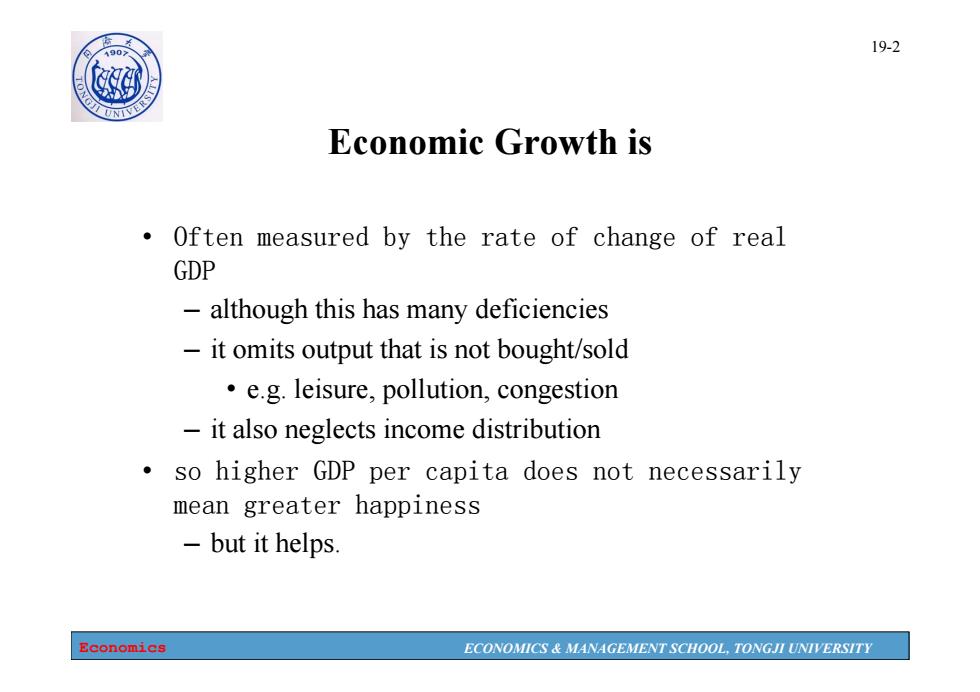
1907 19-2 Economic Growth is Often measured by the rate of change of real GDP although this has many deficiencies it omits output that is not bought/sold .e.g.leisure,pollution,congestion it also neglects income distribution so higher GDP per capita does not necessarily mean greater happiness - but it helps. Economics ECONOMICS MANAGEMENT SCHOOL,TONGJI UNIVERSITY
Economics ECONOMICS & MANAGEMENT SCHOOL, TONGJI UNIVERSITY 19-2 Economic Growth is • Often measured by the rate of change of real GDP – although this has many deficiencies – it omits output that is not bought/sold • e.g. leisure, pollution, congestion – it also neglects income distribution • so higher GDP per capita does not necessarily mean greater happiness – but it helps
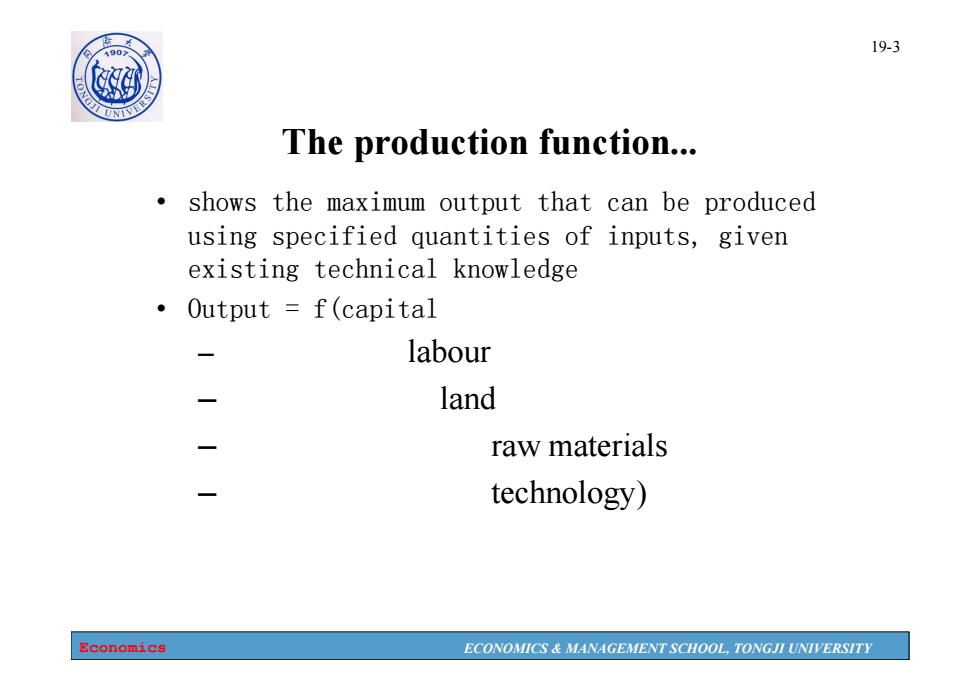
19-3 The production function... shows the maximum output that can be produced using specified quantities of inputs,given existing technical knowledge ·Output=f(capital labour land raw materials technology) Economics ECONOMICS MANAGEMENT SCHOOL,TONGJI UNIVERSITY
Economics ECONOMICS & MANAGEMENT SCHOOL, TONGJI UNIVERSITY 19-3 The production function... • shows the maximum output that can be produced using specified quantities of inputs, given existing technical knowledge • Output = f(capital – labour – land – raw materials – technology)
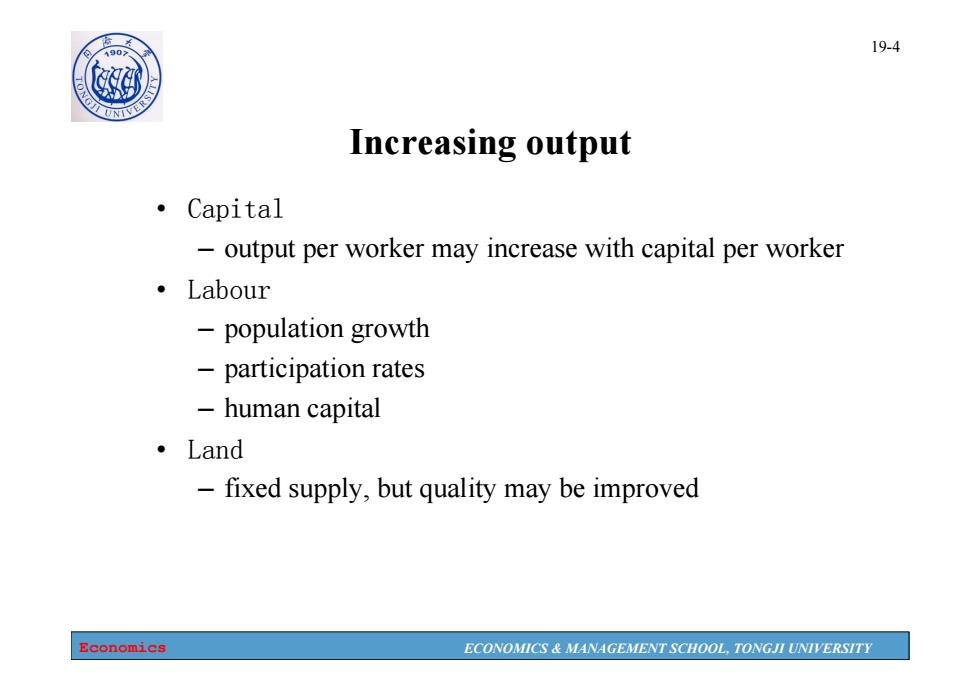
1907 19-4 Increasing output Capital output per worker may increase with capital per worker 。Labour -population growth participation rates -human capital ·Land -fixed supply,but quality may be improved Economics ECONOMICS MANAGEMENT SCHOOL,TONGJI UNIVERSITY
Economics ECONOMICS & MANAGEMENT SCHOOL, TONGJI UNIVERSITY 19-4 Increasing output • Capital – output per worker may increase with capital per worker • Labour – population growth – participation rates – human capital • Land – fixed supply, but quality may be improved

19-5 0 Increasing output (2) ·Raw materials -important distinction between depletable resources(coal,oil) renewable resources(timber,fish) ·Technical knowledge inventions,R&D Economies of scale may reinforce the long-run growth process Economics ECONOMICS MANAGEMENT SCHOOL,TONGJI UNIVERSITY
Economics ECONOMICS & MANAGEMENT SCHOOL, TONGJI UNIVERSITY 19-5 • Raw materials – important distinction between • depletable resources (coal,oil) • renewable resources (timber, fish) • Technical knowledge – inventions, R&D • Economies of scale may reinforce the long-run growth process Increasing output (2)
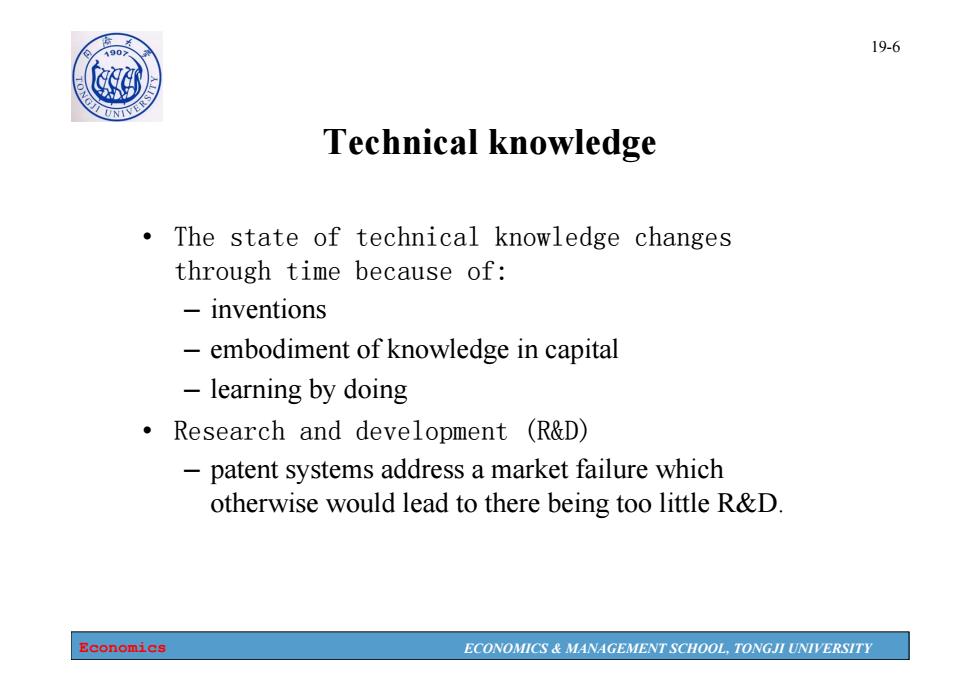
1907 19-6 Technical knowledge The state of technical knowledge changes through time because of: -inventions embodiment of knowledge in capital learning by doing Research and development (R&D) patent systems address a market failure which otherwise would lead to there being too little R&D. Economics ECONOMICS MANAGEMENT SCHOOL,TONGJI UNIVERSITY
Economics ECONOMICS & MANAGEMENT SCHOOL, TONGJI UNIVERSITY 19-6 Technical knowledge • The state of technical knowledge changes through time because of: – inventions – embodiment of knowledge in capital – learning by doing • Research and development (R&D) – patent systems address a market failure which otherwise would lead to there being too little R&D
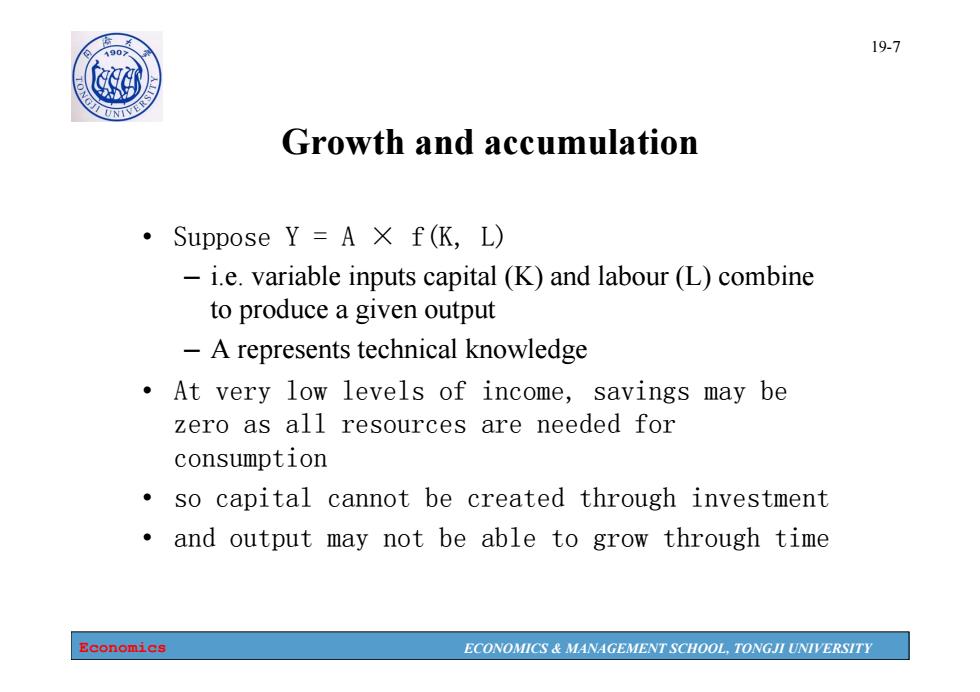
197 Growth and accumulation Suppose Y=A x f(K,L) -i.e.variable inputs capital (K)and labour(L)combine to produce a given output -A represents technical knowledge At very low levels of income,savings may be zero as all resources are needed for consumption so capital cannot be created through investment and output may not be able to grow through time Economics ECONOMICS MANAGEMENT SCHOOL,TONGJI UNIVERSITY
Economics ECONOMICS & MANAGEMENT SCHOOL, TONGJI UNIVERSITY 19-7 Growth and accumulation • Suppose Y = A × f(K, L) – i.e. variable inputs capital (K) and labour (L) combine to produce a given output – A represents technical knowledge • At very low levels of income, savings may be zero as all resources are needed for consumption • so capital cannot be created through investment • and output may not be able to grow through time

1907 19-8 Theories of growth:some key terms Along a steady-state path output,capital and labour are all growing at the same rate,so output per worker and capital per worker are constant ·Capital--widening extends the existing capital per worker to new extra workers ·Capital deepening -raises capital per worker for all workers Economics ECONOMICS MANAGEMENT SCHOOL,TONGJI UNIVERSITY
Economics ECONOMICS & MANAGEMENT SCHOOL, TONGJI UNIVERSITY 19-8 Theories of growth: some key terms • Along a steady-state path – output, capital and labour are all growing at the same rate, so output per worker and capital per worker are constant • Capital-widening – extends the existing capital per worker to new extra workers • Capital deepening – raises capital per worker for all workers
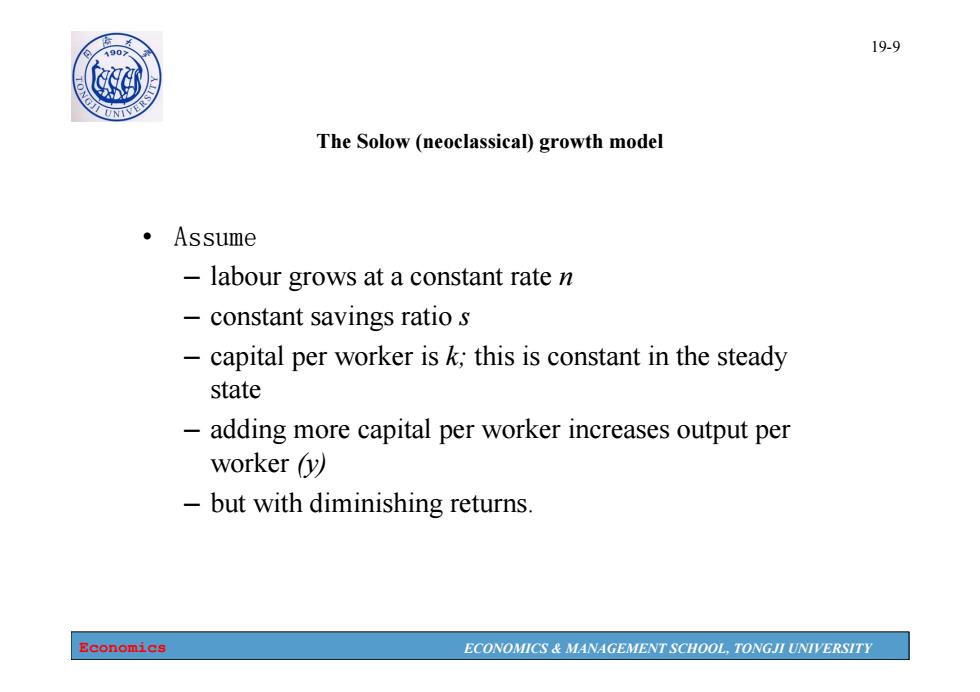
19-9 The Solow (neoclassical)growth model ·Assume labour grows at a constant rate n constant savings ratio s -capital per worker is k;this is constant in the steady state adding more capital per worker increases output per worker (v) but with diminishing returns Economics ECONOMICS MANAGEMENT SCHOOL,TONGJI UNIVERSITY
Economics ECONOMICS & MANAGEMENT SCHOOL, TONGJI UNIVERSITY 19-9 The Solow (neoclassical) growth model • Assume – labour grows at a constant rate n – constant savings ratio s – capital per worker is k; this is constant in the steady state – adding more capital per worker increases output per worker (y) – but with diminishing returns
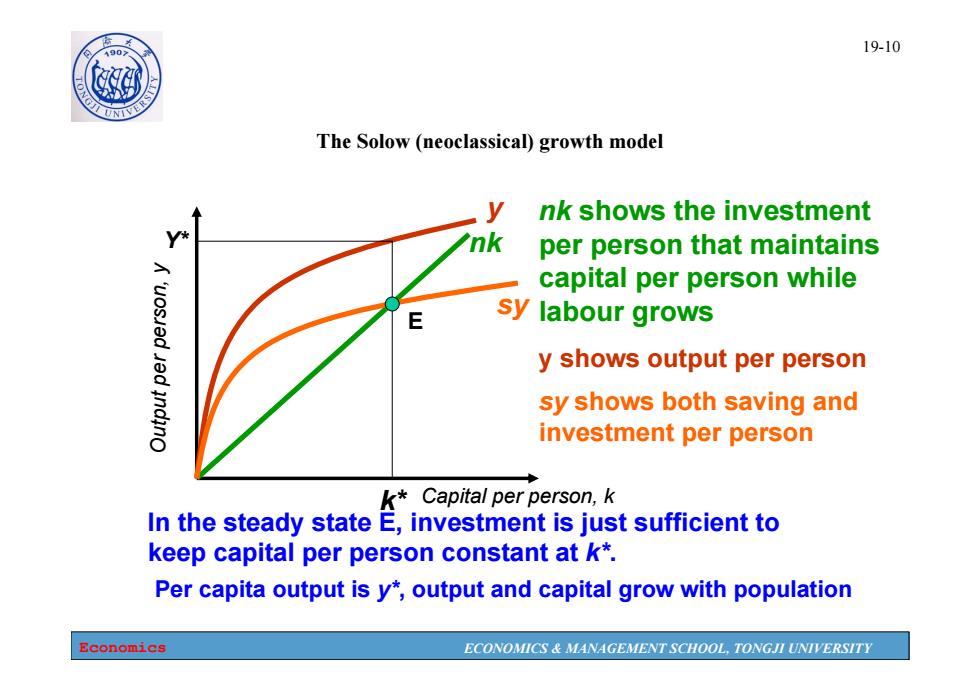
490 19-10 The Solow (neoclassical)growth model nk shows the investment nk per person that maintains capital per person while sy labour grows y shows output per person sy shows both saving and investment per person K*Capital per person,k In the steady state E,investment is just sufficient to keep capital per person constant at k*. Per capita output is y*,output and capital grow with population Economics ECONOMICS MANAGEMENT SCHOOL,TONGJI UNIVERSITY
Economics ECONOMICS & MANAGEMENT SCHOOL, TONGJI UNIVERSITY 19-10 The Solow (neoclassical) growth model Capital per person, k O u pt u t p e r p e rs o n , y nk nk shows the investment per person that maintains capital per person while labour grows y y shows output per person sy sy shows both saving and investment per person Y* Per capita output is y*, output and capital grow with population k* In the steady state E, investment is just sufficient to keep capital per person constant at k*. E